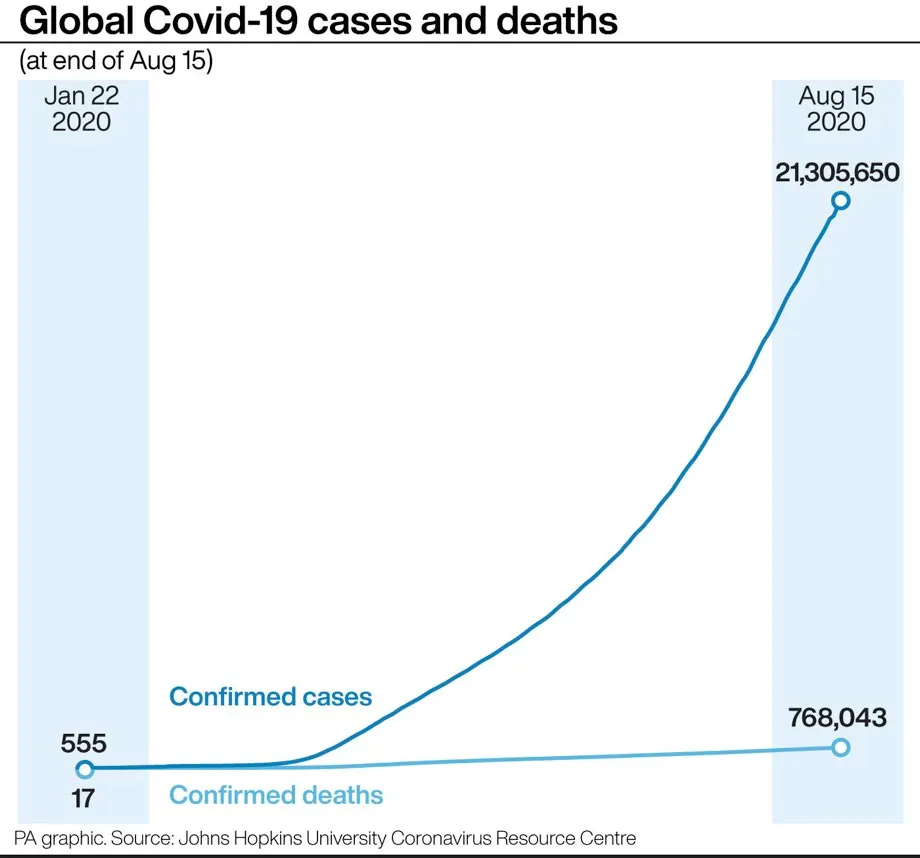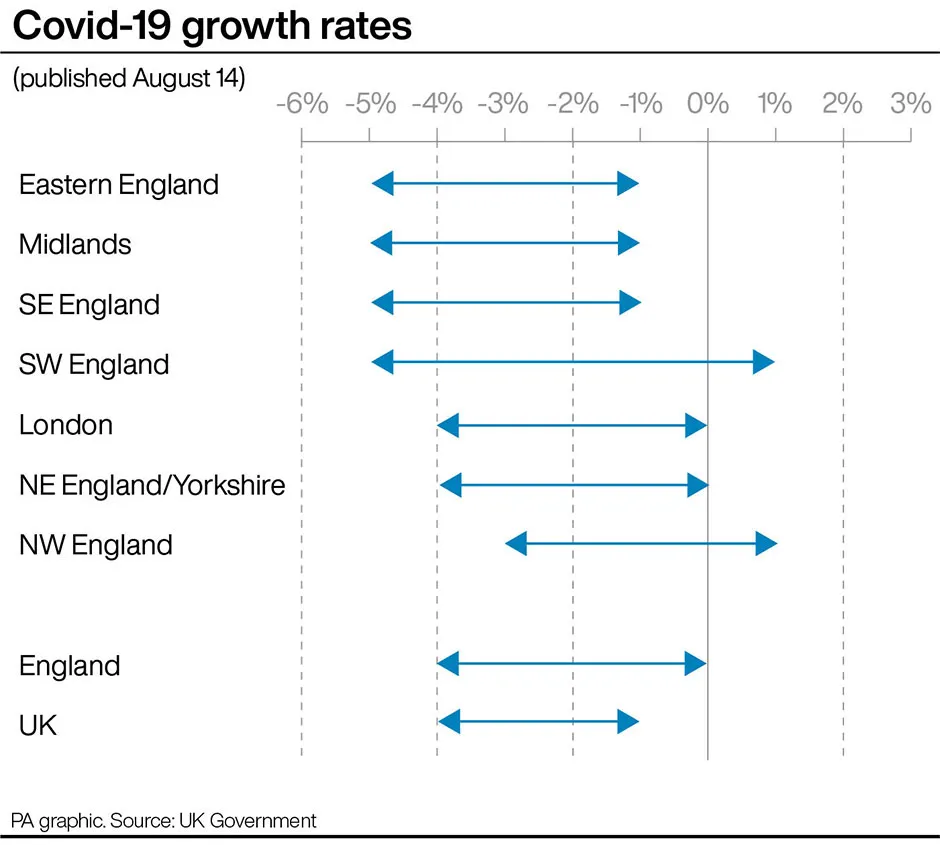The growth rate of coronavirus transmission, which reflects how quickly the number of infections is changing day by day, has changed slightly across the UK since last week, with early indications the value may be increasing.
Figures published on Friday by the Government Office for Science and the Scientific Advisory Group for Emergencies (Sage) has shown the growth rate to be between minus 4 per cent and minus 1, a slight change from between minus 5 per cent and zero last week.
Meanwhile, the reproduction number (R)for the UK as a whole remains unchanged at between 0.8 and 1.
Read more about the spread of COVID-19:
- COVID-19: Psychological 'nudges' change intentions but not behaviour
- Drinking in pubs creates 'perfect storm' for spreading coronavirus
The R number represents the number of people each COVID-19-positive person goes on to infect. In England, the latest data gives R between 0.8 and 1, but Sage has indicated it is not confident that R is currently below one in the region. Regional R values also appear to be close to 1.
The estimates for R and growth rate are provided by the Scientific Pandemic Influenza Group on Modelling (SPI-M), a subgroup of Sage.
It said: “We are starting to see early indications that these values may be increasing. This is not yet reflected in these estimates because the data used to calculate R and growth rate reflect the situation from a few weeks ago.”

A time delay between initial infection and the need for hospital care usually means it may take two to three weeks for the changes in the spread of COVID-19 to be reflected in the estimates. But models that use COVID-19 testing data, which have less of a time delay, indicate higher values for R in England, the Government Office for Science statement said.
It added: “For this reason, Sage does not have confidence that R is currently below one in England. We would expect to see this change in transmission reflected in the R and growth rate published over the next few weeks as we gain more certainty of what is currently happening.”
However, the government officials and advisers said is also important to recognise that these are estimates, and there is a high degree of uncertainty with them. They said these figures are less useful in determining the state of the epidemic when disease incidence is low and local outbreaks could be contributing to the variability in the numbers.

In the east of England, the growth rate has changed from between minus 4 per cent and minus 1 per cent last week, to between minus 5 per cent and minus 1 per cent. The R number is 0.8-1.
In London, the growth rate is between minus 4 per cent and zero, compared with between minus 4 per cent and plus 1 per cent last week. The capital has an R value of 0.8-1.
The Midlands has a growth rate of between minus 5 per cent and minus 1 per cent, compared with between minus 3 per cent and zero last week. Its R value is 0.8-1.
Whereas the headline value for the range of R values has remained unchanged since last week, we should note that apart from the South East, for all other regions of England, the higher end of the R range is 1, or even 1.1 for the North West
Dr Yuliya Kyrychko
In the North East and Yorkshire, the growth rate remains unchanged since last week and is somewhere between minus 4 per cent and zero. Its R number is 0.8-1.
The growth rate in the North West also remains unchanged and is between minus 3 per cent and plus 1 per cent. The R value here is 0.8-1.1.
In the South East, the growth rate is between minus 5 per cent and minus 1 per cent, compared with minus 4 per cent to zero last week. The R value in the region is 0.8-0.9.
The situation is pretty much on the precipice, and then it can develop very rapidly, which means that all possible caution should be taken by the public
Dr Yuliya Kyrychko
The South West has seen its growth rate decline slightly from between minus 3 per cent and plus 3 per cent last week to between minus 5 per cent and plus 1 per cent. Its R value has a range of 0.8-1.
Across England, the growth rate is between minus 4 per cent and zero, compared with between minus 3 per cent and zero last week.
Commenting on the figures, Dr Daniel Lawson, lecturer in statistical science at University of Bristol’s School of Mathematics, said: “Sage appropriately warn they are not confident that R is currently below 1, for two reasons.
“Firstly, there is significant uncertainty in the data, and modelling this is very difficult. Secondly, the data are observed with a time lag, so we can only know R in the past with certainty. R is very close to 1, and these uncertainties combine to make it plausible – though not yet likely – that R is currently above 1.”
Read the latest coronavirus news:
- Coronavirus: This is not the beginning of a second wave – we're still trying to end the first, says expert
- COVID-19: Children play 'limited role' in coronavirus pandemic
Dr Yuliya Kyrychko, reader in mathematics at University of Sussex, added: “Whereas the headline value for the range of R values has remained unchanged since last week, we should note that apart from the South East, for all other regions of England, the higher end of the R range is 1, or even 1.1 for the North West.
“Although there is uncertainty associated with estimating the value of R number, particularly when the numbers of new infections are low, the fact that the seven-day average of new daily infections has been steadily increasing since the middle of July suggests that it is very likely that the view of Sage on R number not being below 1 is correct.
“What this means in practical terms is that the situation is pretty much on the precipice, and then it can develop very rapidly, which means that all possible caution should be taken by the public.”
Can I get the coronavirus from a parcel?
It’s hypothetically possible, but parcels pose a very small risk.
A US study found that the coronavirus can survive for up to 24 hours on cardboard (and paper is likely to be similar). So for the parcel to be contaminated, someone with COVID-19 would have had to touch or cough on your parcel within the past day.
The chances of this are low, but common sense advice would be to wash your hands with soap and water after opening the parcel, and then again after you’ve disposed of the packaging – especially if you or anyone else in your household is in one of the vulnerable groups.
The same study found that the virus can survive for up to three days on hard, shiny surfaces such as plastic and stainless steel – which is why door handles are particularly good vectors for the virus. So, if you receive anything packaged in plastic, such as takeaway deliveries, make sure to wash your hands after touching it, and especially before eating.
We don’t yet know how long the virus can survive on smartphone screens, but it’s likely to be up to three days. This means that you should ideally clean your phone with disinfectant wipes (Apple recommends 70 per cent isopropyl alcohol wipes), at least once a day.
Read more: